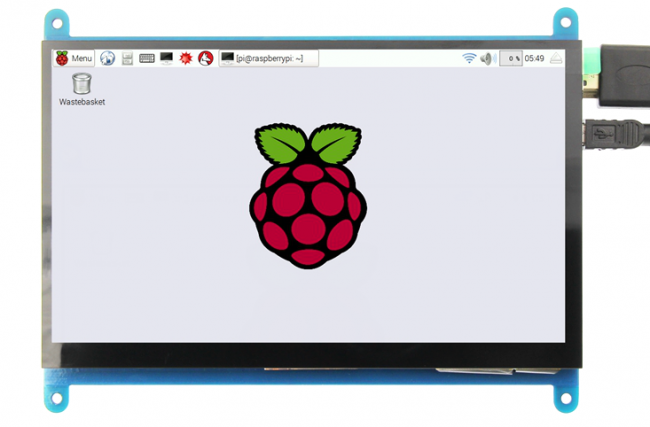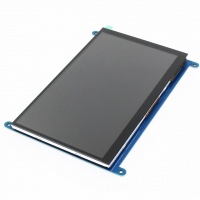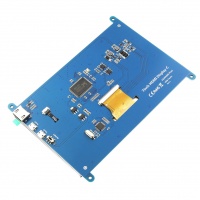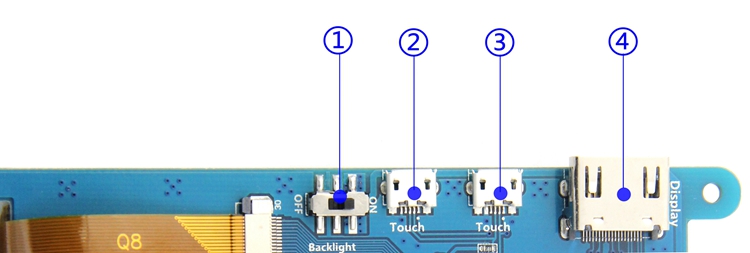Line 6:
Line 6: }}
}}
<tabber>
Description=
== <font color="blue">Product Video</font> ==
== <font color="blue">Product Video</font> ==
{{#ev:youtube|yHehh-cVZbE}}
{{#ev:youtube|yHehh-cVZbE}}
Line 86:
Line 84: *[http://www.lcdwiki.com/res/MPI7002/MPI7002_Product_Dimensions.png MPI7002_Product_Dimensions]
*[http://www.lcdwiki.com/res/MPI7002/MPI7002_Product_Dimensions.png MPI7002_Product_Dimensions]
== <font color="blue">How to modify the display orientation</font> ==
{{rotate}}
* '''[[How to modify the display orientation-CTP(En)]]'''
==<font color="blue">Resource</font>==
==<font color="blue">Resource</font>==
Line 170:
Line 166: [[#top|BACK TO TOP]]
[[#top|BACK TO TOP]]
|-|
FAQ=
<table class="a-r at-c roundy bgd-blue bl-white" style="margin-left: 5px; margin-bottom: 5px;"> <table style="margin-top: 10px; border-right: 20px solid transparent; border-top: 20px solid #008DE6;"><table style="margin-top: 10px; border-right: 20px solid transparent; border-top: 20px solid #008DE6;">
<tr>
<td>
<table class="roundy" style="margin-top: -30px; margin-left: -5px; margin-right: -5px; background: #008DE6;">
<tr>
<td><font color="#FFF"> <big><big>
<br />
Question: Using the Raspberry Pi image provided by the CD/net disk, cannot use the LCD normally.
</big></big></font>
</td></tr></table>
</td></tr></table>
<table style="margin-top: 10px; border-left: 20px solid transparent; border-top: 20px solid #DDD;">
<tr>
<td>
<table class="roundy mw-collapsible" style="margin-top: -30px; margin-left: -5px; margin-right: -5px; background: #DDD;">
<tr>
<td>
=== <font color="#008DE6"> <b><big>Answer:</big></b></font> ===
</td></tr>
<tr>
<td>
* Confirm that the hardware connection is correct and the contact is good.
* Determine whether TF card is normal and whether the system is started normally.
* The PWR lamp is always bright when the Raspberry Pi is started, and the ACT light is flashing.If you find both lights on,
it may be the TF card does not successfully burn the image file,or that the TF card is not in contact with the Raspberry Pi.
* Recommend using 5V 2A power adapter to power the Raspberry Pi.
* If you use a computer USB interface, you may not be able to activate the Raspberry Pi due to insufficient power supply.
</td></tr></table>
</td></tr></table><br /><table style="margin-top: 10px; border-right: 20px solid transparent; border-top: 20px solid #008DE6;">
<tr>
<td>
<table class="roundy" style="margin-top: -30px; margin-left: -5px; margin-right: -5px; background: #008DE6;">
<tr>
<td><font color="#FFF"> <big><big>Question: What is the reason for the LCD not displayed using the image provided by the Raspberry Pi official?</big></big></font>
</td></tr></table>
</td></tr></table>
<table style="margin-top: 10px; border-left: 20px solid transparent; border-top: 20px solid #DDD;">
<tr>
<td>
<table class="roundy mw-collapsible" style="margin-top: -30px; margin-left: -5px; margin-right: -5px; background: #DDD;">
<tr>
<td>
=== <font color="#008DE6"> <b><big>Answer:</big></b></font> ===
</td></tr>
<tr>
<td>
<ul><li>LCD needs to be installed driver to display correctly, please refer to "How to install the LCD driver (En)" related documentation.
</li><li>It is recommended to use the image file provided by us first to test. After the test is passed, use the image file of Raspberry Pi official and installed the driver.
</li></ul>
</td></tr></table>
</td></tr></table><br /><table style="margin-top: 10px; border-right: 20px solid transparent; border-top: 20px solid #008DE6;">
<tr>
<td>
<table class="roundy" style="margin-top: -30px; margin-left: -5px; margin-right: -5px; background: #008DE6;">
<tr>
<td><font color="#FFF"> <b><big><big>Question: How to switch back to traditional monitor for display?</big></big></b></font>
</td></tr></table>
</td></tr></table>
<table style="margin-top: 10px; border-left: 20px solid transparent; border-top: 20px solid #DDD;">
<tr>
<td>
<table class="roundy mw-collapsible" style="margin-top: -30px; margin-left: -5px; margin-right: -5px; background: #DDD;">
<tr>
<td>
=== <font color="#008DE6"><big>Answer<b>:</b></big></font> ===
</td></tr>
<tr>
<td>
<ul><li>Please refer to "How to install the LCD driver (En)" related instruction document, and use the following command:
<pre style="border: 1px dashed black;color:black">
sudo ./LCD-hdmi
</pre>
</li></ul>
</td></tr></table>
</td></tr></table><br /><table style="margin-top: 10px; border-right: 20px solid transparent; border-top: 20px solid #008DE6;">
<tr>
<td>
<table class="roundy" style="margin-top: -30px; margin-left: -5px; margin-right: -5px; background: #008DE6;">
<tr>
<td><font color="#FFF"> <big><big>Question: Why the LCD works but flickers?</big></big></font>
</td></tr></table>
</td></tr></table>
<table style="margin-top: 10px; border-left: 20px solid transparent; border-top: 20px solid #DDD;">
<tr>
<td>
<table class="roundy mw-collapsible" style="margin-top: -30px; margin-left: -5px; margin-right: -5px; background: #DDD;">
<tr>
<td>
=== <font color="#008DE6"> <b><big>Answer:</big></b></font> ===
</td></tr>
<tr>
<td>
<ul><li>This problem is likely due to insufficient power supply.
</li><li>If you are using the Raspberry Pi, please use the power supply of 5V full 2A to power the Raspberry Pi,
</li></ul>and connect the Raspberry Pi and the LCD by the short USB cable we provided.
<ul><li>If it is used as a computer monitor, do not use poor quality USB cable or extension cord connection,
</li></ul>do not receive extend the USB port to get electricity, please use the USB cable we provided.
</td></tr></table>
</td></tr></table><br /><table style="margin-top: 10px; border-right: 20px solid transparent; border-top: 20px solid #008DE6;">
<tr>
<td>
<table class="roundy" style="margin-top: -30px; margin-left: -5px; margin-right: -5px; background: #008DE6;">
<tr>
<td><font color="#FFF"> <big><big>Question: Why the Raspberry Pi unable to work properly after updating the Raspbian system?</big></big></font><font color="#EEE"><big>?</big></font>
</td></tr></table>
</td></tr></table>
<table style="margin-top: 10px; border-left: 20px solid transparent; border-top: 20px solid #DDD;">
<tr>
<td>
<table class="roundy mw-collapsible" style="margin-top: -30px; margin-left: -5px; margin-right: -5px; background: #DDD;">
<tr>
<td>
=== <font color="#008DE6"><big>Answer<b>:</b></big></font> ===
</td></tr>
<tr>
<td>
<ul><li>The update needs to be done in the following manner, otherwise the image cannot run:
<pre style="border: 1px dashed black;color:black">
sudo apt-mark hold raspberrypi-bootloader
sudo apt-get update
sudo apt-get upgrade
</pre>
</li></ul>
</td></tr></table>
</td></tr></table><br /><table style="margin-top: 10px; border-right: 20px solid transparent; border-top: 20px solid #008DE6;">
<tr>
<td>
<table class="roundy" style="margin-top: -30px; margin-left: -5px; margin-right: -5px; background: #008DE6;">
<tr>
<td><font color="#FFF"> <big><big>Question: Why the LCD is connected to the computer HDMI, but cannot be displayed normally?</big></big></font>
</td></tr></table>
</td></tr></table>
<table style="margin-top: 10px; border-left: 20px solid transparent; border-top: 20px solid #DDD;">
<tr>
<td>
<table class="roundy mw-collapsible" style="margin-top: -30px; margin-left: -5px; margin-right: -5px; background: #DDD;">
<tr>
<td>
=== <font color="#008DE6"> <b><big>Answer:</big></b></font> ===
</td></tr>
<tr>
<td>Make sure the HDMI interface of the computer can be output normally.
The computer only connects to the LCD as a display device, and does not connect to other monitors (unplug other monitors).
Connect the USB first, then the HDMI.
Try to restart your computer.
You must use the Windows operating system. <ul><li></li></ul>
</td></tr></table>
</td></tr></table><br /><table style="margin-top: 10px; border-right: 20px solid transparent; border-top: 20px solid #008DE6;">
<tr>
<td>
<table class="roundy" style="margin-top: -30px; margin-left: -5px; margin-right: -5px; background: #008DE6;">
<tr>
<td><font color="#FFF"> <big><big>Question: How to turn on the Bluetooth function on the Raspberry Pi?</big></big></font>
</td></tr></table>
</td></tr></table>
<table style="margin-top: 10px; border-left: 20px solid transparent; border-top: 20px solid #DDD;">
<tr>
<td>
<table class="roundy mw-collapsible" style="margin-top: -30px; margin-left: -5px; margin-right: -5px; background: #DDD;">
<tr>
<td>
=== <font color="#008DE6"><big><b>Anwer:</b></big></font> ===
</td></tr>
<tr>
<td>
<ul><li>Method 1: upgrade to the official latest image of the Raspberry Pi (the Bluetooth function has been turned on by default after 2016-05-27-raspbian-jessie);
</li><li>Method 2: manually turn on Bluetooth.<br />
<pre style="border: 1px dashed black;color:black">
sudo apt-get install pi-bluetooth
sudo apt-get install bluetooth bluez blueman
systemctl status bluetooth
sudo systemctl start bluetooth
sudo reboot
</pre>
</li></ul>
</td></tr></table>
</td></tr></table><br /><table style="margin-top: 10px; border-right: 20px solid transparent; border-top: 20px solid #008DE6;">
<tr>
<td>
<table class="roundy" style="margin-top: -30px; margin-left: -5px; margin-right: -5px; background: #008DE6;">
<tr>
<td><font color="#FFF"> <b><big><big>Question: Why unable to display full screen or incomplete when using 5”, 5”-B, 7”-B, or 7”-C HDMI screen?</big></big></b></font>
</td></tr></table>
</td></tr></table>
<table style="margin-top: 10px; border-left: 20px solid transparent; border-top: 20px solid #DDD;">
<tr>
<td>
<table class="roundy mw-collapsible" style="margin-top: -30px; margin-left: -5px; margin-right: -5px; background: #DDD;">
<tr>
<td>
=== <font color="#008DE6"> <b><big>Answer:</big></b></font> ===
</td></tr>
<tr>
<td>
<ul><li>Check if the HDMI is plugged in and output is normal.
</li><li>Open the config.txt file in the TF card root directory to check the HDMI configuration.
</li><li>5", 5"-B and 7"-B 800*480 should be configured as follows:<br />
<pre style="border: 1px dashed black;color:black">
hdmi_group=2
hdmi_mode=1
hdmi_mode=87
hdmi_cvt 800 480 60 6 0 0 0
</pre>
</li><li>7"-C 1024*600 should be configured as follows:<br />
<pre style="border: 1px dashed black;color:black">
hdmi_group=2
hdmi_mode=1
hdmi_mode=87
hdmi_cvt 1024 600 60 6 0 0 0
</pre>
</li></ul>
</td></tr></table>
</td></tr></table>
<br />
|-|
after-sales=
== <font color="blue">Contact us:</font> ==
{{contact_us}}
</tabber>
Product Video Product pictures
Product Description 7’’ standard display, 1024 × 600 Hardware resolution, Up to 1920x1080 software configuration resolution.
Capacitive touch screen, maximum support 5 point touch
Support backlight control alone, the backlight can be turned off to save power
Support Raspberry Pi, BB Black, Banana Pi and other mainstream mini PC
Can be used as general-purpose-use HDMI monitor, for example: connect with a computer HDMI as the sub-display
Used as a raspberry pi display that supports Raspbian, Ubuntu, Kali-Linux, Kodi, win10 IOT, single-touch, free drive
Work as a PC monitor, support win7, win8, win10 system 5 point touch (XP and older version system: single-point touch), free drive
CE, RoHS certification
Product Parameters Size: 7.0 (inch)
SKU: MPI7002
Resolution: 1024 × 600 (dots)
Touch: five-point capacitive touch
Product Size: 164.9*124.27 (mm)
Package Size: 211*150*53 (mm)
Rough Weight(Package containing): 405 (g)
Power Dissipation: 0.84A*5V Hardware Description
① Backlight Power switch: Controls the backlight turned on and off to save power. ②&③ USB Touch / power supply connector: For power supply and touch output, the functions of the both are the same, can just use one of them. ④ HDMI interface: For connecting motherboard and LCD monitor to HDMI transmission.How to use with Raspbian/Ubuntu Mate/Win10 IoT Core System Step 1, Install Raspbian official image Download the latest image from the official download.
Install the system according to the official tutorial steps. Step 2, modify the “config.txt” After the programming of Step1 is completed, open the config.txt file of TF card root directory and
add the following code at the end of the file, save and eject Micro SD Card safely: max_usb_current=1
hdmi_force_hotplug=1
config_hdmi_boost=7
hdmi_group=2
hdmi_mode=1
hdmi_mode=87
hdmi_drive=1
display_rotate=0
hdmi_cvt 1024 600 60 6 0 0 0
Step 3, Drive the 5inch HDMI Display-B with the Raspberry Pi Insert the TF Card to Raspberry Pi, connect the Raspberry Pi and LCD by HDMI cable; connect USB cable to one of the four USB ports of Raspberry Pi, and connect the other end of the USB cable to the USB port of the LCD; then supply power to Raspberry Pi; after that if the display and touch both are OK, it means drive successfully (please use the full 2A for power supply). How to use as PC monitor Connect the computer HDMI output signal to the LCD HDMI interface by using the HDMI cable
Connect the LCD's USB Touch interface (Either of the two MicroUSB) to the USB port of the device
If there are several monitors, please unplug other monitor connectors first, and use LCD as the only monitor for testing. Product Dimensions How to rotate the display direction This method only applies to the Raspberry Pi series of display screens, other display screens do not apply.
Method 1 ,If the driver is not installed, execute the following command (Raspberry Pi needs to connected to the Internet):sudo rm -rf LCD-show
git clone https://github.com/goodtft/LCD-show.git
chmod -R 755 LCD-show
cd LCD-show/
sudo ./XXX-show 90
After execution, the driver will be installed. The system will automatically restart, and the display screen will rotate 90 degrees to display and touch normally. ' XXX-show ' can be changed to the corresponding driver, and ' 90 ' can be changed to 0, 90, 180 and 270, respectively representing rotation angles of 0 degrees, 90 degrees, 180 degrees, 270 degrees)
Method 2 ,If the driver is already installed, execute the following command:cd LCD-show/
sudo ./rotate.sh 90
After execution, the system will automatically restart, and the display screen will rotate 90 degrees to display and touch normally. 90 ' can be changed to 0, 90, 180 and 270, respectively representing rotation angles of 0 degrees, 90 degrees, 180 degrees, 270 degrees) If the rotate.sh prompt cannot be found, use Method 1 to install the latest drivers
Resource 7inch_HDMI_Display-C_User_Manual(En) How_to_install_the_LCD_driver_V1.2 How_to_install_matchbox-keyboard How_to_calibrate_the_Capacitive_Touch_Screen-V1.0 How_to_use_Raspberry_Pi(Download,Format,Burn,SSH,PuTTy)-V1.0.pdf Local download: LCD-show.tar.gz If you have difficulty installing the driver, or if you still can't use the display properly after installing the driver, Please Try our Configned images for tested. Just need download and write the image into the TF card. DO NOT need any driver installation steps. Panasonic SDFormatter Win32DiskImager PuTTY BACK TO TOP





